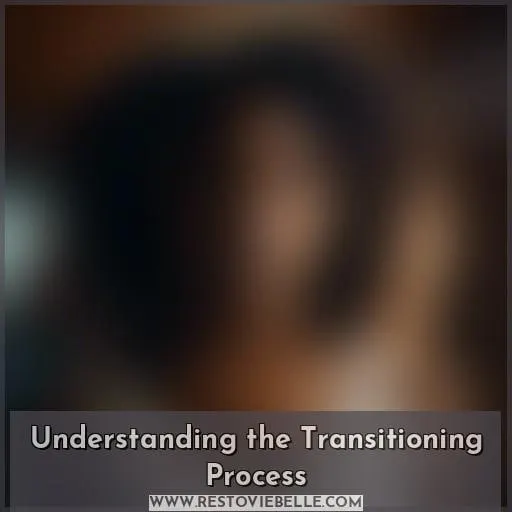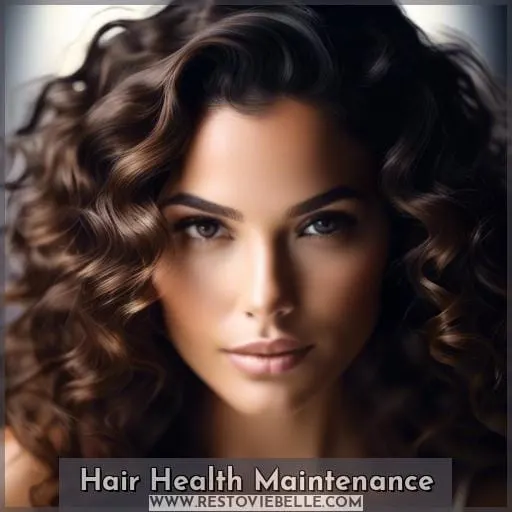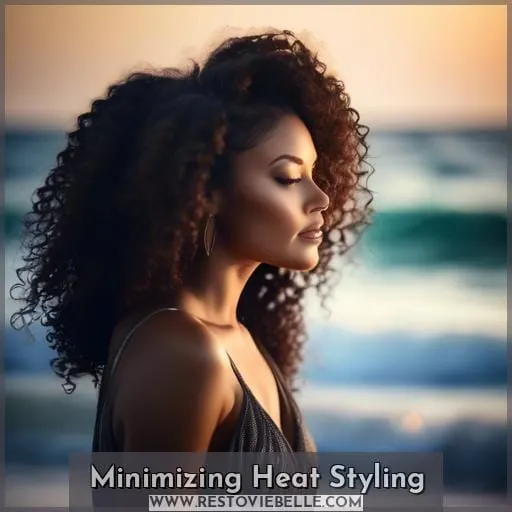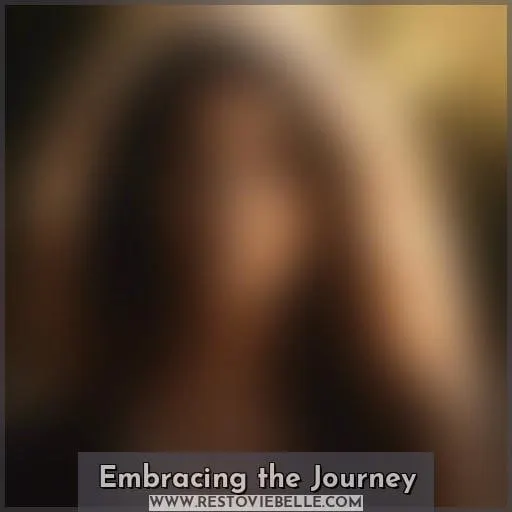This site is supported by our readers. We may earn a commission, at no cost to you, if you purchase through links.
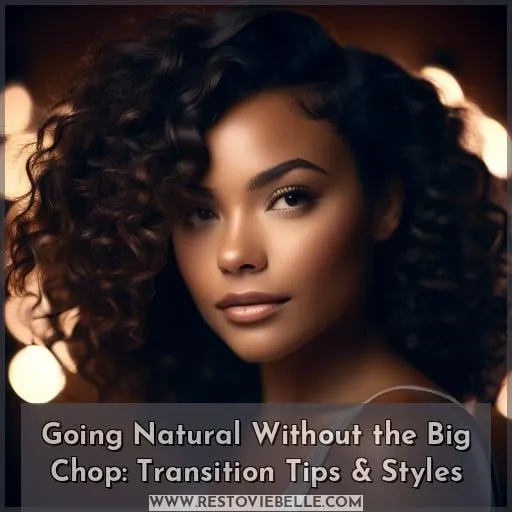 Embarking on the journey to embrace your natural hair texture without resorting to the big chop is a bold step towards self-discovery and liberation. It’s about more than just hair; it’s a commitment to nurturing your roots and celebrating the unique beauty that comes from within.
Embarking on the journey to embrace your natural hair texture without resorting to the big chop is a bold step towards self-discovery and liberation. It’s about more than just hair; it’s a commitment to nurturing your roots and celebrating the unique beauty that comes from within.
As you navigate through managing two textures and exploring protective styles, remember that patience, gentle care, and a focus on hair health are your best allies. This guide is designed to empower you with practical tips and styles that honor your natural hair journey, fostering a sense of community and understanding along the way.
Let’s dive into the transformative experience of going natural without the big chop, embracing every twist and turn with confidence and grace.
Table Of Contents
- Key Takeaways
- Understanding the Transitioning Process
- Protective Styling
- Hair Health Maintenance
- Minimizing Heat Styling
- Embracing the Journey
- Frequently Asked Questions (FAQs)
- How can I deal with different textures in my hair during the transition?
- What are the best ways to handle the emotional aspects of transitioning to natural hair?
- How do I manage expectations from family and friends about my changing hairstyle?
- Can I color my hair during the transition, and if so, how should I do it to minimize damage?
- What are the best strategies for dealing with scalp issues, such as dandruff or itchiness, during the transition?
- Conclusion
Key Takeaways
- Embrace protective styles such as weaves, braids, Bantu knots, and wigs to protect new hair growth and minimize daily manipulation, which can lead to breakage and damage.
- Regularly trim processed ends to gradually transition to natural hair, promoting healthier growth and reducing the appearance of two distinct textures.
- Deep condition weekly to maintain moisture levels, especially important as natural hair may feel drier than relaxed ends, helping to keep hair healthy and hydrated throughout the transition.
- Minimize heat styling to preserve the natural curl pattern and avoid further damage to new growth, using heat protectants when necessary and considering alternative styling methods that do not involve heat.
Understanding the Transitioning Process
Transitioning to natural hair without opting for the big chop is a journey that requires managing two distinct hair textures. This process demands patience and gentle care. You’ll find yourself navigating the complexities of keeping both your natural new growth and relaxed ends healthy and styled in a way that feels seamless.
Embracing protective styles and ensuring your hair is well-moisturized will be key to minimizing breakage and promoting hair health during this time.
Managing Two Hair Textures
Managing two hair textures during your transition from processed to natural hair can feel like you’re walking a tightrope.
On the other, the processed ends that remind you of where you’ve started. It’s a journey of patience, where blending techniques become your best friend, and understanding the texture differences is key.
Think of it as learning a new language, where each curl pattern has its own dialect. The transition timeline isn’t a sprint; it’s a marathon, with hair growth stages marking your progress.
Embrace each phase, from awkward lengths to newfound curls, as milestones in your quest for freedom and self-discovery.
Importance of Patience and Gentle Care
After tackling the challenge of managing two hair textures, it’s crucial to embrace patience and gentle care on your journey to natural hair.
This isn’t just about hair; it’s about self-love and acceptance, weaving time management, stress management, and emotional support into your daily routine.
Your hair’s health is a mirror reflecting your inner well-being. So, chuck the stress, embrace the mess, and let’s embark on this journey with a heart full of patience and hands full of gentleness.
Your curls will thank you, and you’ll discover a newfound appreciation for the natural beauty that’s uniquely yours.
Protective Styling
As you embrace your natural hair texture, protective styles like braids, weaves, and twists can be your best allies. They not only minimize the need for daily hair manipulation, which can lead to breakage but also keep your hair tucked away and safe from environmental stressors.
Benefits of Braids, Weaves, and Twists
As you’ve been managing two hair textures, it’s time to weave in some style while keeping your strands safe.
Protective styling, like braids, weaves, and twists, isn’t just about looking fab; it’s a strategic move for hair growth and scalp health. These styles tuck away your ends, the oldest and most fragile part of your hair, reducing breakage and retaining length.
Plus, they’re a playground for style versatility, letting you flaunt anything from boho braids to twist-out crowns without overworking your natural texture.
Minimizing Hair Manipulation
Braids, weaves, and twists have set the stage for your hair’s freedom march, but let’s not forget the unsung hero: minimizing hair manipulation.
It’s like giving your hair a mini-vacation every day! By reducing the daily tussle with combs and brushes, you’re preserving your natural curl pattern and keeping breakage at bay.
Think of it as a gentle nudge towards healthier locks. So, keep up the protective styling, embrace gradual trimming, and dodge the heat like it’s a bad hair day waiting to happen.
Your perseverance and self-discovery through this journey will be your crowning glory!
Hair Health Maintenance
Transitioning to natural hair without opting for the big chop involves a journey of patience and care.
Regular deep conditioning treatments are your best friend in this process, providing your hair with the moisture and nutrients it needs to stay healthy and resilient.
Gradually trimming off processed ends, rather than all at once, allows you to maintain length while slowly getting rid of damaged hair.
This approach ensures a smoother transition and keeps your hair looking its best every step of the way.
Regular Deep Conditioning Treatments
Deep conditioning is your secret weapon to keeping both your natural and transitioning hair thriving. Think of it as the ultimate spa day for your strands, offering a much-needed moisture boost and protein balance to keep breakage at bay and shine on point.
- Deep Conditioning Frequency: Aim to deep condition every wash day, but listen to your hair’s needs. Overdoing it can lead to mushy, over-moisturized locks, so find your sweet spot.
- Moisture Replenishment & Protein Balance: Strike a balance between hydration and strength. Use products that cater to your hair’s porosity to ensure moisture and protein are absorbed effectively, keeping your hair resilient and healthy.
- Scalp Health & Porosity Testing: Don’t forget about your scalp and the importance of knowing your hair’s porosity. A healthy scalp promotes healthy hair growth, and understanding porosity ensures you’re using the right products for maximum benefit.
Embrace this journey with patience and love for your hair, and you’ll see the transformation unfold beautifully.
Gradual Trimming of Processed Ends
Trimming those processed ends gradually is like guiding your hair through a gentle detox. Think of it as pruning a plant; you’re not just chopping for the sake of it but nurturing growth and health.
By snipping off those split ends bit by bit, you’re preventing hair breakage and encouraging growth stimulation. It’s a marathon, not a sprint, so patience is key. This approach ensures moisture and length retention, keeping those locks luscious.
And while you’re at it, tuck your hair into protective styles like a cozy blanket, minimizing manipulation and safeguarding your strands on their journey to freedom.
Minimizing Heat Styling
When you’re transitioning to your natural hair texture, it’s crucial to minimize heat styling to preserve your natural curl pattern and protect the new growth from damage.
You’ll need to be patient and gentle with your hair, embracing styles that don’t require heat and using the lowest heat settings if you must.
Preserving Natural Curl Pattern
After diving deep into the essentials of hair health maintenance, it’s crucial to pivot towards preserving your natural curl pattern.
This journey is less about fighting against natural shrinkage and more about embracing and enhancing your curls through protective styling, product experimentation, moisture retention, and diligent scalp care.
So, let’s keep those curls intact and thriving by prioritizing gentle care and embracing the beauty of your natural texture.
Avoiding Further Damage to New Growth
As you embrace your natural hair journey, remember that your new growth is like a tender seedling in a garden—it needs protection to thrive.
- Protective layering: Start with a leave-in conditioner to moisturize and defend your strands.
- Co-washing: Swap out harsh shampoos for co-washing to cleanse without stripping natural oils.
- Leave-in conditioners: These are your hair’s best friend, keeping it hydrated and less prone to breakage.
- Scalp massages and finger detangling: Treat your scalp to massages to stimulate growth, and ditch the comb for your fingers to gently untangle knots.
Laugh in the face of heat damage and let your curls bounce freely, knowing you’re nurturing them right from the roots!
Embracing the Journey
Embracing your journey to natural hair is a profound act of self-discovery and appreciation for your inherent beauty.
It’s essential to arm yourself with patience and perseverance, as transitioning without the big chop is a gradual process that unfolds over time.
Celebrate each milestone along the way, recognizing that every step brings you closer to fully embracing your natural texture and authentic self.
Self-discovery and Natural Beauty Appreciation
As you’ve been steering clear of heat to protect your new curls, you’re also embarking on a voyage of self-discovery. Embracing your natural hair journey is like unwrapping a gift that’s been with you all along, revealing the authentic you.
It’s a celebration of diversity, a testament to hair identity, and a love letter to self. Growth and acceptance aren’t just about inches; they’re about blooming into your truest self.
So, laugh in the face of bad hair days and remember, every coil and kink is a chapter of your unique story.
Patience and Perseverance Through the Transition
As you’ve begun to see your natural beauty in a new light, remember that transitioning is a marathon, not a sprint.
- Time Management: Juggling the demands of life with hair care can be tricky. Set aside dedicated time for your hair routine to ensure it doesn’t fall by the wayside.
- Gradual Progress: Celebrate each small victory. Your hair’s journey is unique, and each inch of new growth is a triumph.
- Setbacks and Triumphs: The emotional rollercoaster is real. One day you’re on cloud nine with a perfect twist-out; the next, you’re battling a stubborn knot. But with each setback, your hair confidence grows.
Hang in there! The path to hair freedom is paved with patience and perseverance.
Frequently Asked Questions (FAQs)
How can I deal with different textures in my hair during the transition?
Embrace your hair’s unique journey with patience and creativity. Experiment with styles like twists or braids that celebrate both textures.
Moisturize religiously, and remember, deep conditioning is your best friend. You’re not alone in this; we’ve all been there, wrestling with our tresses.
Keep your chin up and scissors down; you’re unlocking the true essence of your hair, one curl at a time.
What are the best ways to handle the emotional aspects of transitioning to natural hair?
Embrace the journey; it’s not just about hair, it’s about self-discovery.
Connect with like-minded souls, celebrate small victories.
How do I manage expectations from family and friends about my changing hairstyle?
Navigating family and friends’ reactions to your evolving hairstyle can be a challenging but empowering journey. Remember, it’s your crown, not a group project. Embrace the importance of this personal transformation as you express your individuality through your hair.
Share inspiring natural hair transformations with those around you to showcase the beauty and diversity of different styles. Lean on supportive communities, whether online or in person, who can provide encouragement and understanding during this process.
Patience is key in this transition; not everyone will immediately understand or appreciate your choices. Embrace your unique texture and style, knowing that true confidence comes from staying true to yourself.
Remember, those who matter won’t mind your changes, and those who mind don’t truly matter in the grand scheme of things.
Can I color my hair during the transition, and if so, how should I do it to minimize damage?
Yes, you can color your hair during the transition, but tread lightly. Imagine painting on a delicate canvas; your strands are that canvas, vulnerable and yearning for gentle care.
Opt for semi-permanent dyes or treatments like Olaplex to minimize damage. Envision your hair as a garden; just as you wouldn’t douse your flowers with harsh chemicals, avoid permanent dyes and embrace your hair’s natural journey with nurturing, less aggressive options.
What are the best strategies for dealing with scalp issues, such as dandruff or itchiness, during the transition?
To tackle dandruff or itchiness, use a shampoo with zinc pyrithione or salicylic acid.
Moisturize with natural oils like coconut or jojoba.
Don’t forget to gently massage your scalp—it’s a real game-changer.
Conclusion
Like a butterfly emerging from its cocoon, going natural without the big chop is a journey of transformation and self-discovery. It’s about embracing your unique beauty and nurturing your hair with patience and gentle care.
Protective styles, such as braids, weaves, and twists, play a crucial role in minimizing hair manipulation and preserving your natural curl pattern. Regular deep conditioning treatments and gradual trimming of processed ends are essential for maintaining hair health.
By minimizing heat styling, you avoid further damage and allow your new growth to flourish. Embrace this journey with patience and perseverance, and celebrate each step towards revealing the natural beauty that has been there all along.
